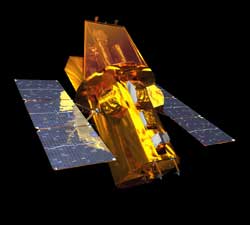The Neil Gehrels Swift Observatory
 Gamma-ray bursts (GRBs) are the most powerful explosions the Universe has seen since the Big Bang. They occur approximately once per day and are brief, but intense, flashes of gamma radiation. They come from all different directions of the sky and last from a few milliseconds to a few hundred seconds. So far scientists do not know what causes them. Do they signal the birth of a black hole in a massive stellar explosion? Are they the product of the collision of two neutron stars? Or is it some other exotic phenomenon that causes these bursts?
Gamma-ray bursts (GRBs) are the most powerful explosions the Universe has seen since the Big Bang. They occur approximately once per day and are brief, but intense, flashes of gamma radiation. They come from all different directions of the sky and last from a few milliseconds to a few hundred seconds. So far scientists do not know what causes them. Do they signal the birth of a black hole in a massive stellar explosion? Are they the product of the collision of two neutron stars? Or is it some other exotic phenomenon that causes these bursts?
With Swift, a NASA mission with international participation, scientists have a tool dedicated to answering these questions and solving the gamma-ray burst mystery. Its three instruments give scientists the ability to scrutinize gamma-ray bursts like never before. Within seconds of detecting a burst, Swift relays its location to ground stations, allowing both ground-based and space-based telescopes around the world the opportunity to observe the burst's afterglow. Swift is part of NASA's medium explorer (MIDEX) program and was launched into a low-Earth orbit on a Delta 7320 rocket on November 20, 2004. The Principal Investigator is Dr. Brad Cenko (NASA-GSFC).
» NASA Release
» Multimedia
» Nature Paper
Swift Operations Status
Operations are nominal.
Swift Resources
» GRB, BA, & TOO Contact Information» BAT Transient Lightcurves
» Swift Supernovae
» Observing Schedule
» Journal Papers Related to Swift
» Swift Press Release Image Archive
» Swift User's Group (SUG)
» Swift Mission Participants
Latest Swift GRBs
Latest Swift News
Swift Users Workshop, Aug 20, 2024
Jul 19, 2024
The Swift team is excited to announce an upcoming online workshop specifically designed for Swift users on August 20th from 11 am to 1 pm EDT. In this workshop, the respective instrument teams (BAT, XRT, and UVOT) will update the community on instrument status, their latest pipelines, and data analysis techniques developed to assist users. These updates will guide users in proposing their science cases in a well-informed manner. The workshop will also provide guidance on how to review a proposal. There will be a significant amount of time devoted to questions from the attendees.
+ Read More
ROSES-24 Amendment 23: D.5 Swift General Investigator Amendment: IXPE Joint Observing Program and Change to NuSTAR Exclusive-Use Period
Jun 25, 2024
D.5 Neil Gehrels Swift Observatory General Investigator (GI) - Cycle 21 solicits proposals for basic research relevant to the Swift gamma-ray burst mission. The primary goal of this mission is to determine the origin of gamma-ray bursts (GRBs) and use these bursts to probe the early Universe. Two changes have been made to D.5 Swift GI: 1) A joint GI observing program with Imaging X-ray Polarimetry Explorer has been added and 2) all NuSTAR data acquired through the Swift GI Program will have a standard 6-month exclusive-use period, see Section 1.3.2. New text is in bold and deleted text is struck through. The proposal due date is unchanged: Phase-1 proposals are due by 4:30 p.m. Eastern time on September 26, 2024, via ARK/RPS.
On or about June 24, 2024, this Amendment to the NASA Research Announcement "Research Opportunities in Space and Earth Sciences (ROSES) 2024" (NNH24ZDA001N) will be posted on the NASA research opportunity homepage and will appear on SARA's ROSES blog.
Programmatic information concerning D.5 Swift GI may be obtained from Mario Perez and Technical questions concerning this program element may be directed to Bindu Rani.
Jun 18, 2024
Astronomers See a Massive Black Hole Awaken in Real Time
In late 2019 the previously unremarkable galaxy SDSS1335+0728 suddenly started shining brighter than ever before. To understand why, astronomers have used data from several space and ground-based observatories, to track how the galaxy's brightness has varied. In a study out today, they conclude that they are witnessing changes never seen before in a galaxy - likely the result of the sudden awakening of the massive black hole at its core.
+ Read More
If you're a Swift Team member looking for the Team site, try:
NOTE: You will need your Team username and password to access this site.

